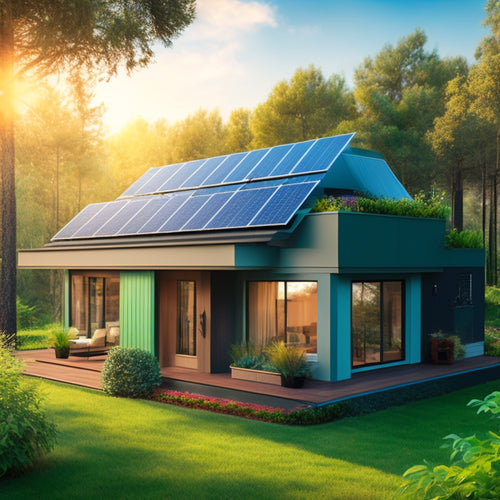
7 Microgrid Control Tips for Energy-Savvy Homeowners
Share
By taking control of your microgrid, you can maximize energy independence and minimize grid reliance. Start by monitoring your energy production and optimizing energy storage capacity. Manage energy distribution efficiently, scheduling usage strategically to minimize waste. Track consumption patterns to identify areas for improvement and balance grid and renewable energy sources. Secure seamless grid connection and synchronization to optimize energy flow. Finally, prioritize reliability and maintenance strategies to assure consistent power supply. As you refine your microgrid control system, you'll access new opportunities to enhance efficiency and reduce costs.
Key Takeaways
- Monitor energy production and consumption in real-time to identify areas for improvement and optimize microgrid performance.
- Optimize energy storage capacity by assessing energy usage patterns and adjusting battery technology for a stable and reliable power supply.
- Balance load priorities by allocating power to critical loads and managing non-essential loads to minimize energy waste and maximize efficiency.
- Schedule energy usage strategically by coordinating with microgrid generation patterns and shifting non-essential loads to off-peak hours.
- Implement smart charging systems and load management strategies to optimize energy flow paths and minimize transmission losses.
Monitor Your Energy Production
During peak sun hours, your microgrid is generating clean energy, and monitoring its production is crucial to enhance your system's performance.
You need to keep track of how much energy your solar panels are producing to guarantee you're getting the most out of your system. Considering the impact of orientation and tilt angles on energy production efficiency, it's important to refine your solar panel layout for your specific geographic location and climate.
Solar panel monitoring allows you to analyze energy production analytics in real-time, identifying areas for improvement and potential issues.
By monitoring your energy production, you can adjust your consumption habits to match your energy output, reducing reliance on the grid and maximizing your energy independence.
With accurate data, you can fine-tune your microgrid to achieve peak performance, reducing energy waste and saving you money.
Optimize Energy Storage Capacity
Since your microgrid's energy storage capacity plays a vital role in ensuring a stable and reliable supply of power, it's essential to optimize it for maximum efficiency.
You'll want to assess your energy usage patterns and adjust your battery technology accordingly. By doing so, you'll be able to store excess energy generated during the day for use during periods of high demand or when the grid is down.
Integrating solar power can reduce grid reliance by up to 70% peak shaving benefits, leading to significant cost savings.
Energy forecasting will also help you predict your energy needs and adjust your storage capacity accordingly.
Manage Energy Distribution Efficiently
You'll need to manage your microgrid's energy distribution efficiently to guarantee reliable power supply and minimize energy waste.
To do so, you'll want to optimize energy flow paths, balance load priorities, and monitor real-time status to make informed decisions.
By integrating renewable energy sources, such as solar-powered fast charging, you can reduce your carbon footprint and improve energy distribution.
Additionally, implementing smart charging systems can reduce energy waste and carbon emissions, optimizing grid usage during off-peak hours.
Optimize Energy Flow Paths
Optimizing energy flow paths is critical to guarantee your microgrid operates efficiently, as it directly impacts your energy savings and overall system reliability. By optimizing energy flow, you can reduce energy losses, increase system flexibility, and improve overall performance. To achieve this, you'll need to implement effective energy routing strategies that assure energy flows through the most efficient paths.
| Energy Flow Optimization Strategies | Benefits |
|---|---|
| Prioritize local energy consumption | Reduces transmission losses |
| Employ energy storage for peak shaving | Optimizes energy supply and demand |
| Implement time-of-use pricing | Encourages energy-efficient behavior |
| Leverage load management systems | Automates energy distribution and optimization |
Balance Load Priorities
To guarantee your microgrid operates at peak efficiency, you need to balance load priorities and manage energy distribution efficiently. This involves allocating power to critical loads, like refrigeration and medical equipment, while shaving non-essential loads.
By adopting solar charging solutions, you can reduce your energy expenditure by up to 50% renewable energy source and optimize your energy storage and generation resources.
Load shedding, a key aspect of demand response, allows you to curtail non-essential loads during periods of high energy demand or grid instability. By prioritizing energy distribution, you can ascertain your microgrid operates within its capacity, reducing the risk of brownouts or blackouts.
You can also optimize energy storage and generation resources, such as solar panels and batteries, to meet your energy needs. By balancing load priorities, you'll maintain a stable and efficient energy supply, enabling you to live life on your own terms.
Monitor Real-Time Status
During peak energy usage hours, it's vital to monitor your microgrid's real-time status to manage energy distribution efficiently.
You'll want to keep a close eye on your energy production and consumption to avoid overload or energy waste. By adopting a hybrid approach optimizing energy usage, you can control consumption and minimize costs and environmental impact.
Additionally, regular maintenance, including cleaning, is essential for solar panel performance and energy efficiency. To do this, employ a monitoring system that provides real-time alerts and status visualization.
This will enable you to quickly identify areas of inefficiency and make adjustments accordingly. With real-time data, you can optimize your energy distribution, ensuring that your home's energy needs are met while minimizing waste.
Schedule Energy Usage Strategically
By coordinating your energy usage with your microgrid's generation patterns, you can minimize waste and maximize efficiency. This means shifting non-essential loads to off-peak hours when energy generation is more abundant.
With time of use pricing, energy rates vary depending on the time of day, so it pays to adjust your usage accordingly. For instance, running your dishwasher or washing machine during off-peak hours can help reduce your energy bills.
Additionally, energy peak shaving strategies can help reduce your energy consumption during peak hours, further reducing waste and costs.
Track Energy Consumption Patterns
Your microgrid's performance data holds the key to optimizing its operation and maximizing your energy independence. By tracking your energy consumption patterns, you can identify areas of inefficiency and opportunities for improvement. Conducting regular energy audits helps you understand your consumption trends, allowing you to make informed decisions about your energy usage.
| Time of Day | Energy Consumption (kWh) | Appliance/Device |
|---|---|---|
| 7:00 AM | 2.5 | Refrigerator |
| 12:00 PM | 4.2 | Air Conditioning |
| 6:00 PM | 1.8 | Electric Oven |
| 10:00 PM | 0.5 | TVs and Computers |
Balance Grid and Renewable Energy
As you gain understanding into your energy consumption patterns, it's time to optimize your microgrid's performance by balancing grid and renewable energy sources.
This balance is essential for ensuring a reliable and efficient energy supply. You'll want to prioritize renewable integration, allowing your solar panels or wind turbines to generate power when possible.
Meanwhile, grid flexibility enables your microgrid to seamlessly switch between renewable and grid energy. By optimizing this balance, you'll reduce your reliance on the grid, decrease energy costs, and increase your energy independence.
Ensure Seamless Grid Connection
The grid connection plays a critical role in your microgrid's overall performance, allowing you to draw energy from the grid when needed and feed excess energy back into the system. To guarantee a seamless connection, you'll need to implement grid synchronization techniques and connection reliability strategies.
| Technique | Description |
|---|---|
| Phase-Locked Loop (PLL) | Synchronizes your microgrid's frequency with the grid's frequency |
| Frequency-Watt (FW) Control | Regulates power output based on grid frequency |
| Voltage-Watt (VW) Control | Regulates power output based on grid voltage |
| Active Power Filtering (APF) | Eliminates harmonics and improves power quality |
| Grid Support Functions (GSF) | Provides grid stability and support during disturbances |
Frequently Asked Questions
How Do I Prioritize Energy Usage During Peak Demand Hours?
As you traverse the energy terrain, prioritize usage during peak demand hours by implementing energy efficiency strategies, like scheduling appliances and adjusting thermostat settings, to excel in peak demand management and claim your independence from the grid.
Can I Use My Microgrid During a Grid Outage?
During a grid outage, you can rely on your microgrid's battery storage to power your home, ensuring outage preparedness and energy independence, as long as you've properly sized and configured your system to meet your energy needs.
Do I Need a Professional to Install My Microgrid System?
You'll likely need a professional to install your microgrid system, considering the complexity of integrating multiple energy sources and ensuring safety. This adds to the upfront cost, but it's essential for a smooth installation timeline and ideal performance.
Are Microgrid Systems Compatible With All Renewable Energy Sources?
You'll be surprised to know that 80% of renewable energy systems can be integrated with microgrid technologies! When it comes to renewable integration, you'll find that microgrid systems are compatible with most sources, including solar, wind, hydro, and geothermal energy.
How Often Should I Perform Maintenance on My Microgrid System?
You should establish and follow regular maintenance schedules to guarantee your microgrid system's ideal performance and longevity, performing tasks like inspecting connections, cleaning components, and updating software to prevent equipment failure and data breaches.
Related Posts
-

3 Green HVAC Filters for Solar-Powered Homes
When outfitting your solar-powered home with an HVAC system, you'll want to choose filters that align with your commi...
-

Green Deck Options: Earth-Conscious Choices for Your Home
You're looking for a deck that not only enhances your home's exterior but also aligns with your eco-friendly values. ...
-

10 Best Sustainable Waste Management Solutions for Green Homes
You're likely unaware that the average green home generates over 2 kilograms of waste daily, but with the right susta...


